Using the quilt-as-you-go (QAYG) technique, you can make this easy Seaside Boardwalk quilt block! A fun sewing project that makes a great pillow or bag.

Today I’m happy to be sharing another quilting project! It’s been a while since I shared a quilt block tutorial, but if my stats are to be believed — you all LOVE them. This year, I’m hoping to share a new quilt-as-you-go (QAYG) block each month, though with twins on the way, I’m not holding onto anything too tightly.
If you’re unfamiliar with QAYG, it’s a foundation piecing technique that quilters often use to make a log cabin block (here’s a great tutorial from Oh Fransson!). A while back I decided this technique was much more versatile than it’s given credit for. If you’re completely unfamiliar with the technique, I created a SUPER easy Big Stripes block that can help teach you the method.
This block is actually fairly simple to make if you understand the QAYG concept. I’ve decided to call it Seaside Boardwalk because it reminds me of a planked boardwalk spanning over the gray water of the sea (thanks to Brittney and Siobhan for helping me name the block!). Of course, you can make it in whatever color combination you choose!
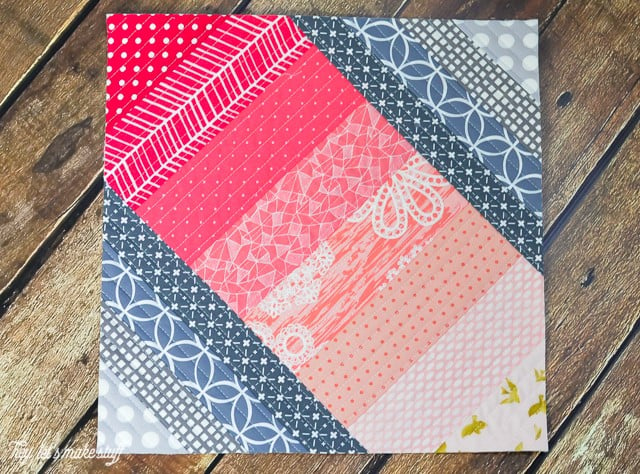
Start by laying out your fabrics. You will need a selection of fabric for the center, and a different selection for the sides. I always love a good gradient, so that’s generally what I choose. You’ll notice in my final block that I didn’t end up using all the fabrics I chose — I just picked exactly what I wanted as I went along.
You are also going to need a 13″ square of batting, and a 13″ square of backing fabric. I use cheap white fabric for the back (I think it’s $1.99 a yard). The final block size will be 12.5″ square, but I like a little extra for trimming.
IMPORTANT: Like I’ve said before, the back of QAYG is ugly (I mean ugly) — and I haven’t found a way to connect the blocks in a pleasing way. So I usually use the technique to make pillows and bags — things with a lining. Perhaps this is the year I’ll figure out how to connect them, and make a pretty backing.
Using the 45° line on my cutting mat, I drew two lines on my batting to help guide my center stripe. My lines are 7.5″ apart, but again, you could make the stripe as wide or narrow as you’d like.
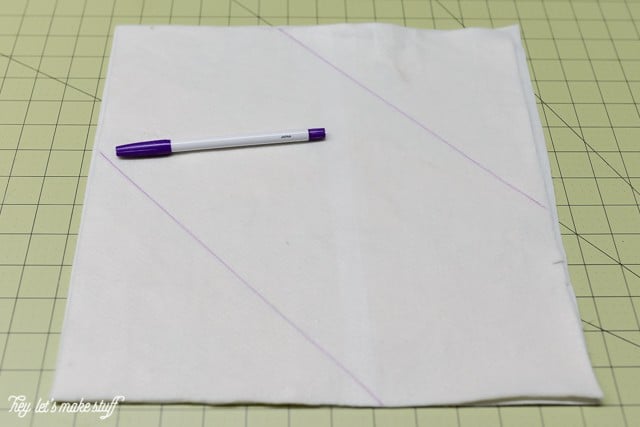
My pink strips in the middle of my block are cut to 2.5″ wide, and the gray strips are 1.5″ wide. You can use whatever width you choose, though. Start by placing the first fabric, right-side up, in the corner of your batting. I used my clear ruler to help make sure I was placing my strips perpendicular to the lines I drew (in the photo below, you can see my purple line underneath the ruler toward the bottom).

Quilt the fabric directly to the batting and backing fabric, using straight lines. I lengthen my stitch a little — my machine doesn’t have numbers, but it’s a little longer than a standard stitch, but not quite as long as a basting stitch.

You can trim off the excess fabric as you go if you’d like. (I just LOVE the gold birds in the Brambleberry Ridge line — I can’t get enough of them!)
Add your second piece of fabric, right-side down on top of the first piece.
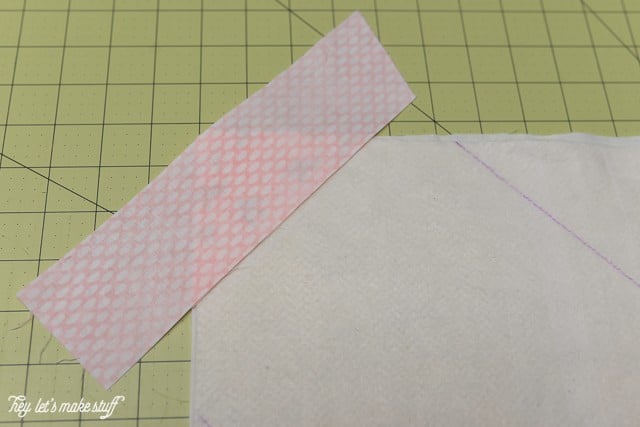
You are going to stitch very close along the edge of the two fabrics, 1/8″ away from the edge. If you look closely at the below photo, you can see my line of white stitching (sorry, it’s a bit hard to see).
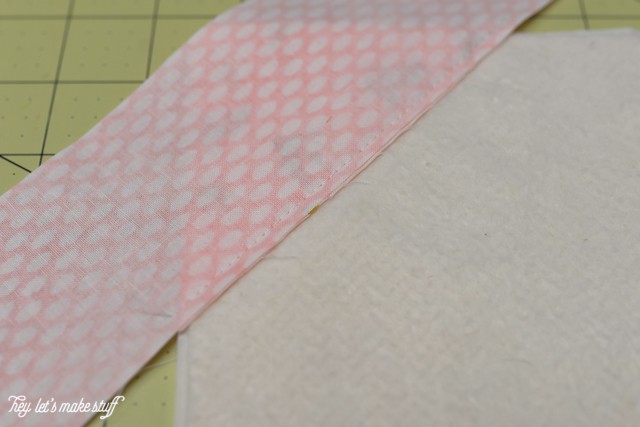
Open that piece and press in the opposite direction.
Quilt to the backing fabric, using straight lines, and trim as needed.
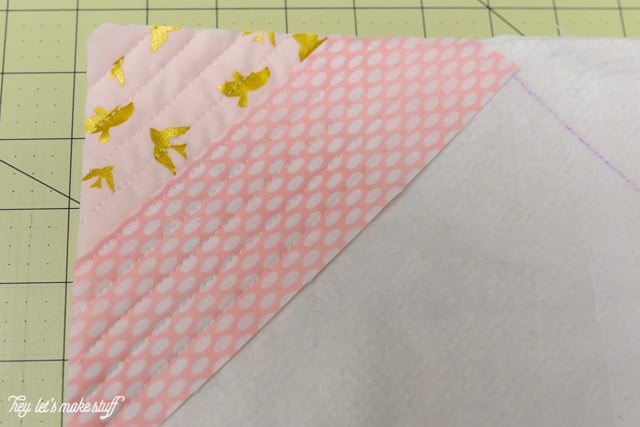
Continue adding strips of fabric down the middle, using your clear ruler to make sure they are perpendicular to your drawn lines.
Once you get to the last piece, you can square up your block and trim off the excess. You’ll see that I have extra batting and fabric in the lower right corner — I just squared up my block from that corner.
Now it’s time to add your side strips. My drawn lines were covered at this point, but I lined up my first gray pieces perpendicular to the pink pieces using my clear ruler, and sewed them down along the outside edge like I did with the pink pieces.

Then I opened them, pressed, and quilted them down.
Then add the gray pieces until you reach the end. I made my final pieces just a hair thicker so they’d reach all the way to the corners.
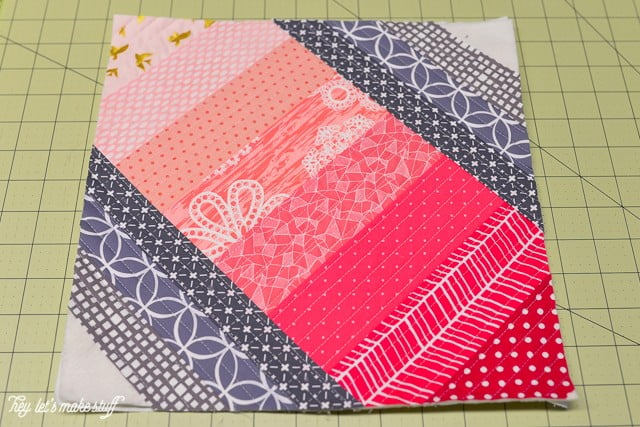
Square it up one more time if you need to, and then you’re done!
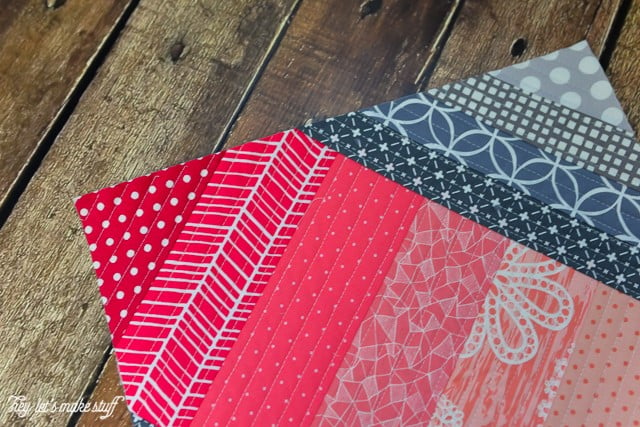
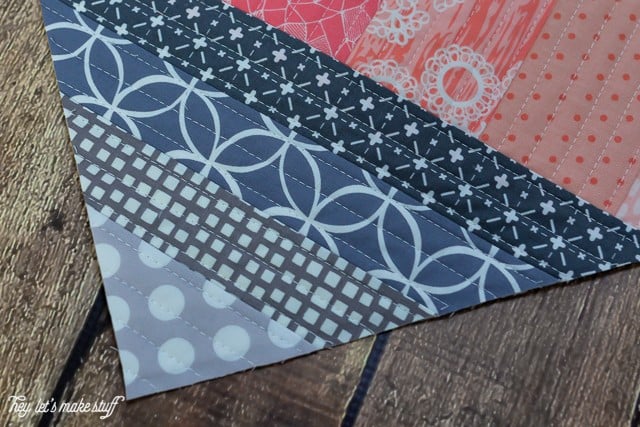
As always, if you have any questions about this (or any of my tutorials), feel free to ask in the comments!
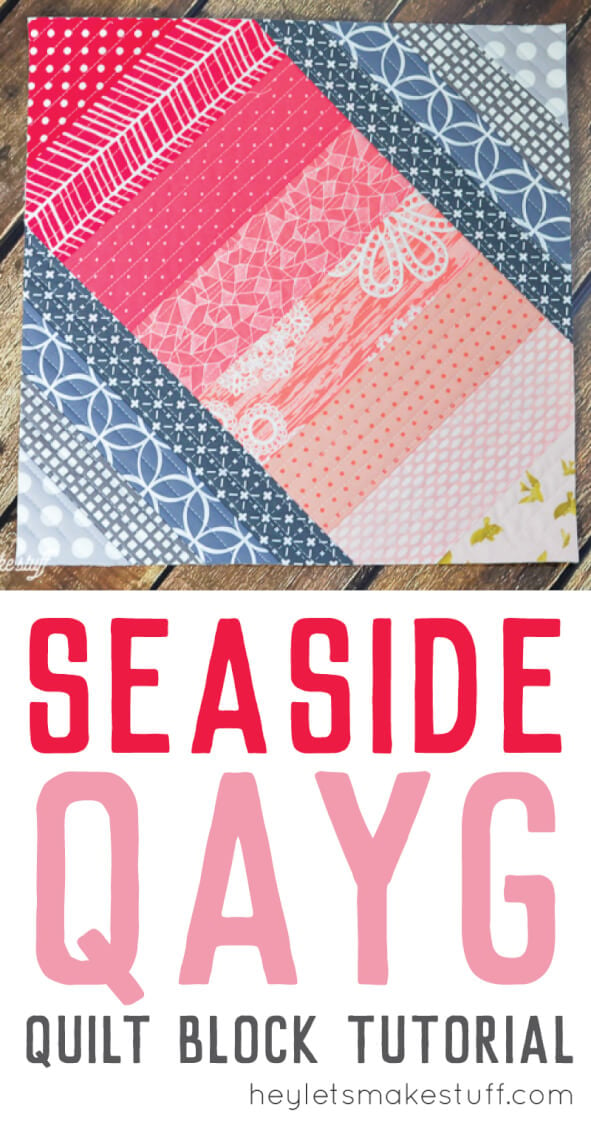
More Quilt as You Go Tutorials:
- Learn Quilt-As-You-Go: Easy Big Stripes Panel
- Bloomin’ Quilt-As-You-Go Tutorial
- Seaside Boardwalk Quilt-As-You-Go Tutorial
- Scattered Geese Quilt-As-You-Go Tutorial
- Go Fly a Kite Quilt-As-You-Go Tutorial
- Step It Up Quilt-As-You-Go Tutorial
- Bear Mountain Quilt-As-You-Go Tutorial
- Scottish Thistle QAYG Block
- North West Quilt-As-You-Go Block Tutorial
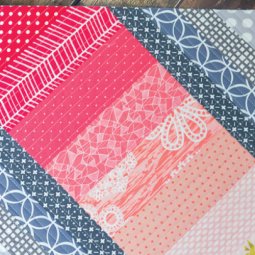
SEASIDE BOARDWALK QUILT-AS-YOU-GO
Supplies
- Fabric
- 13"x13" square batting
- 13"x13" square backing fabric
Instructions
- Start by laying out your fabrics. You will need a selection of fabric for the center, and a different selection for the sides. Love a good gradient, so that's generally what is chosen. You'll notice in the final block that all the fabrics chosen weren't used – just picked exactly what was needed as the quilt blocked progressed.

- You are also going to need a 13" square of batting, and a 13" square of backing fabric. The final block size will be 12.5" square, but I like a little extra for trimming.Using the 45° line on the cutting mat, draw two lines on the batting to help guide the center stripe. The lines are 7.5" apart, but again, you could make the stripe as wide or narrow as you'd like.

- The pink strips in the middle of the block are cut to 2.5" wide, and the gray strips are 1.5" wide. You can use whatever width you choose, though. Start by placing the first fabric, right-side up, in the corner of your batting. Used a clear ruler to help make sure the strips were being placed perpendicular to the drawn lines (in the photo below, you can see the purple line underneath the ruler toward the bottom).

- Quilt the fabric directly to the batting and backing fabric, using straight lines. The stitch was lengthened a little — as this machine doesn't have numbers, but it's a little longer than a standard stitch, but not quite as long as a basting stitch.

- You can trim off the excess fabric as you go if you'd like.

- Add your second piece of fabric, right-side down on top of the first piece.

- You are going to stitch very close along the edge of the two fabrics, 1/8" away from the edge. If you look closely at the below photo, you can see the line of white stitching (sorry, it's a bit hard to see).

- Open that piece and press in the opposite direction.

- Quilt to the backing fabric, using straight lines, and trim as needed.

- Continue adding strips of fabric down the middle, using your clear ruler to make sure they are perpendicular to your drawn lines.




- Once you get to the last piece, you can square up your block and trim off the excess. You'll see that there is extra batting and fabric in the lower right corner — so the block was just squared up from that corner.

- Now it's time to add your side strips. The drawn lines are covered at this point, so just line up the first gray pieces perpendicular to the pink pieces using the clear ruler, and sew them down along the outside edge like what was done with the pink pieces.

- Open them, the press, and quilt them down.

- Then add the gray pieces until you reach the end. The final pieces were made just a hair thicker so they'd reach all the way to the corners.

- Square it up one more time if you need to, and then you're done!

- IMPORTANT: Like I've said before, the back of QAYG is ugly (I mean ugly) — and I haven't found a way to connect the blocks in a pleasing way. So I usually use the technique to make pillows and bags — things with a lining.

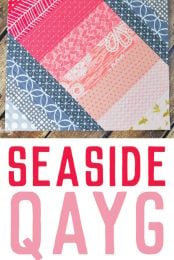


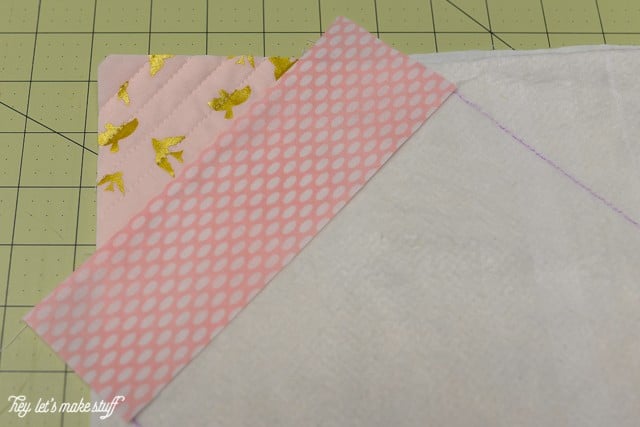
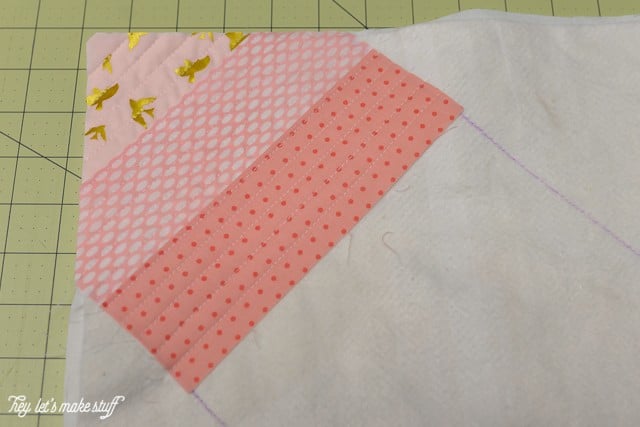
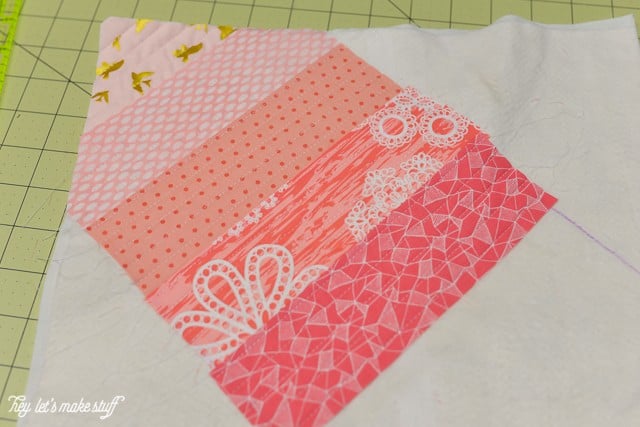
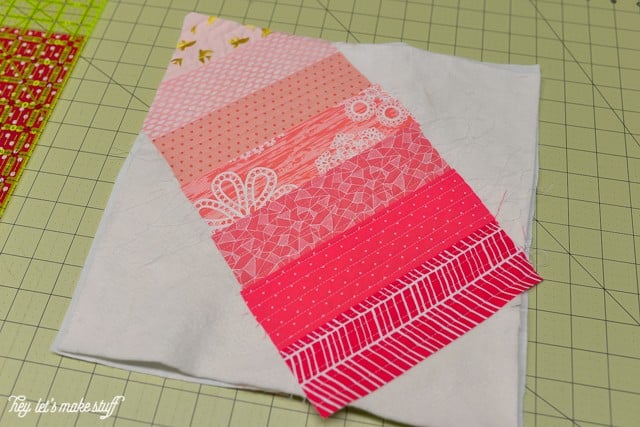
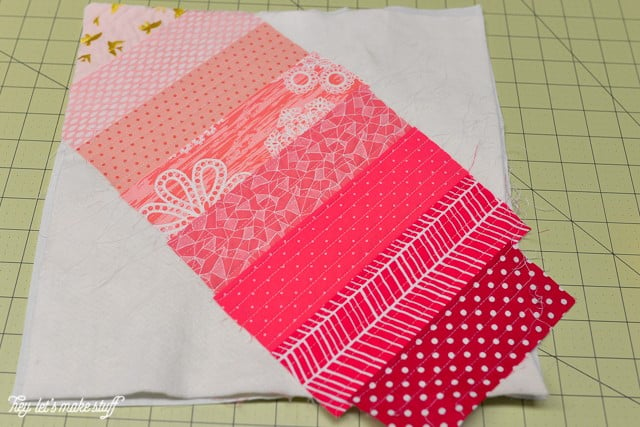
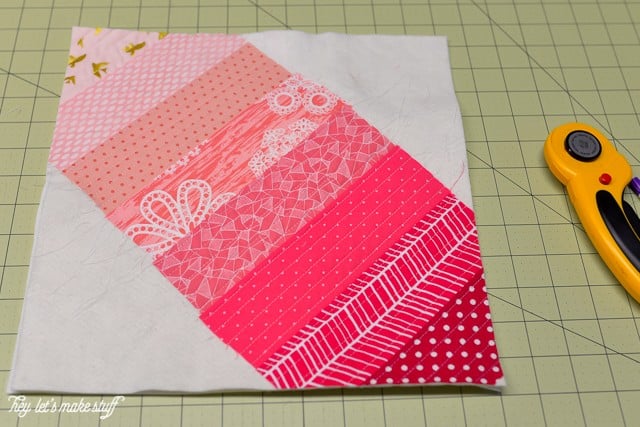
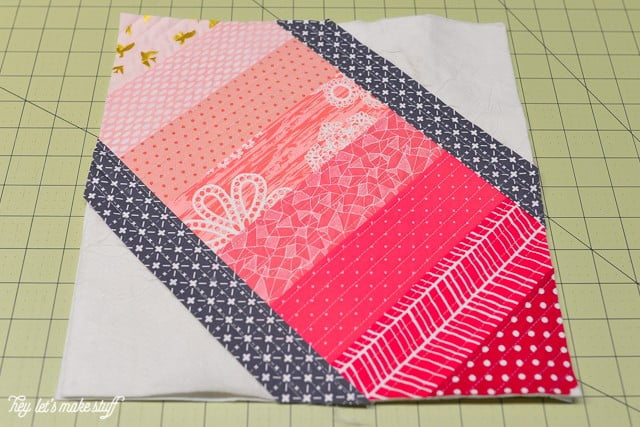
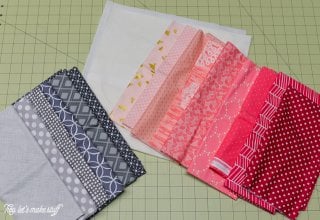
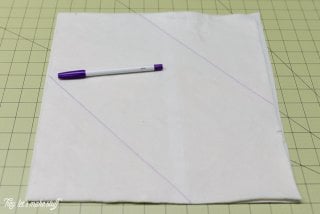
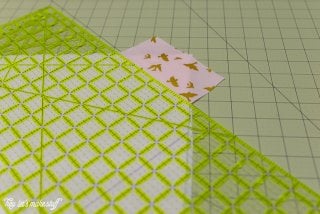
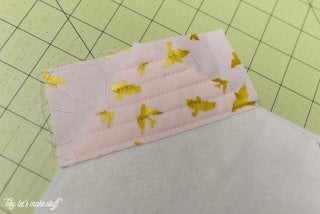
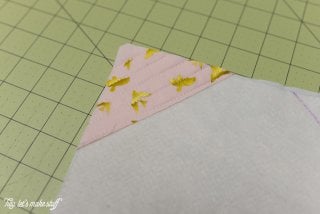

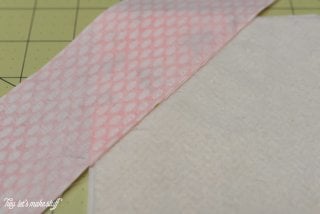
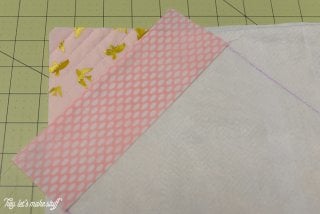
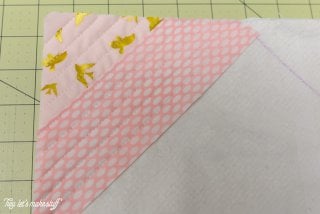
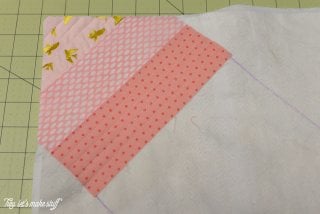

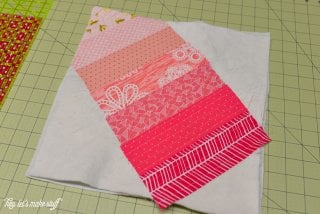

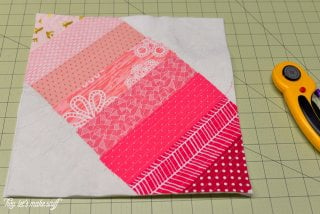

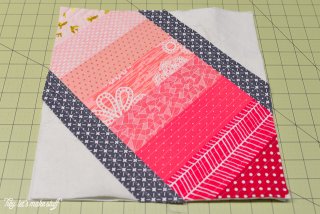
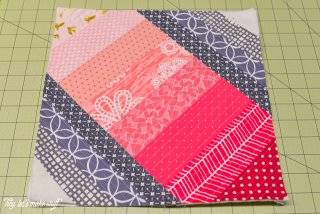
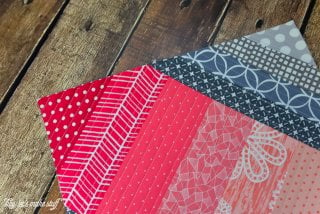
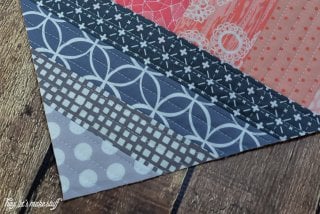


Comments & Reviews
Gwendy Burtz says
This is very concise and easy to follow! thanks so much for sharing!
Cori George says
So glad you found it helpful!
Alene says
Thanks for sharing I love the QAYG method and your pictorials are great your blocks are amazing
Cheers
Deborah Triplett says
How do you joint these squares together if you want to make a quilt. dtriplett333@gmail.com
Deborah
Laurie T says
So do you have a photo of what a quilt would look like, using this same block, repeated, joined together?
Cori George says
I don’t, sorry!
Cori George says
I don’t, Laurie — I’ve never actually made a quilt with these blocks. Sorry!
Chris Reeske says
Okay, so as soon as I posted my note above the photos showed up! Who knew? Hope it stays that way.
Chris Reeske says
I cannot see any photos. I’ve tried Chrome, I.E. and Firefox, nothing shows up. Got any ideas ? I saw a photo of the block on Pinterest and really like it, so I can probably reproduce it, but I’d like to see more of your blog. Thanks
Erin says
Can you post a picture of the underside of the quilt, please? It looks gorgeous!
Cori George says
The underside is…ugly! I just use cheap cotton for backing fabric. I usually turn these into bags or pillows because the back ain’t pretty.
Barbara Starr says
Thank you soon much, I love this Block!
Cori George says
You’re so welcome! :)
Leslie Schmidt says
Hi Cori, I like this block a lot. The only QAYG I’ve done I used Penny Layman’s technique (SewTakeaHike.) She attaches the pieces onto the batting only, then she sews the blocks together like a normal quilt and adds the backing as usual. The quilt then needs only a few stitch in the ditch quilting lines to hold it all together. You have to handle the large quilt, but using a walking foot and just doing straight lines isn’t too bad. You do have to clean out the bobbin area more often, because the batting will collect there. Another possibility is to use a very thin backing under the batting and still add a normal backing. That would add another layer of fabric, but it might not be too heavy.
Kathy Wilkey says
I love your tutorials on QAYG and have used them several times. I use Leah Day’s method for connecting blocks and really like it. I am working on a Building Blocks Quilt and will connect the blocks by her method. I also used this method when I was working on a queen size quilt and wanted to do some “fancy” quilting on the 15″ drop. I pieced and quilted the rectangle that would cover the bed, pieced and quilted each of the four drops, then used Leah Day’s method to join the drops to the main rectangle. It was easy and I am very pleased with the results.
Graham Purcell says
One way to join the blocks into a quilt would be to use another backing piece and sew bias (or straight) strips between the blocks. Sort out the blocks into whatever pattern you prefer then using a wide width, carefully zigzag them together in rows and then zigzag the rows together. You will then have your quilt top. The piece of backing should be as large as the top plus a little more -about 3 inches all round should do. Pin all layers together as usual then starting from the middle of the quilt sew a band straight down one joined seam sewing as close to the side edge of the band, then sew up the other side. Continue this way covering all the seams and voila! Trim the sides and bind in the usual way.
Donna Hunt says
To stitch together…..cut backing about 2″all around, then sew backing edges, rt sides together, close to block edge . Turn over and fold backing over front to form sashing. You can make sashing as wide as you want. On this particular block, you wouldn’t want to destroy the lines, so I’d cut the backing smaller to make the sashing narrower.
Btw, there’s a ruler set available.